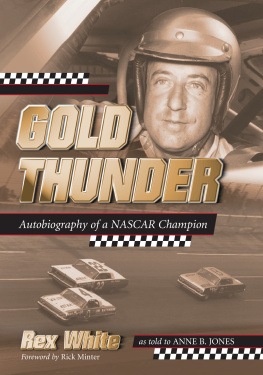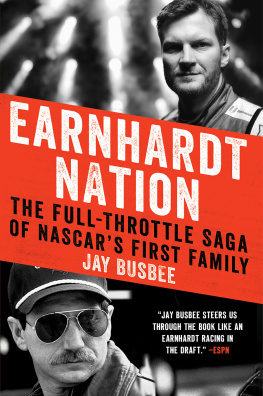GOLD THUNDER
Autobiography of a NASCAR Champion
by Rex White
as told to Anne B. Jones
with a foreword by Rick Minter

McFarland & Company, Inc., Publishers
Jefferson, North Carolina
Photographs are from the Rex White collection unless otherwise credited
LIBRARY OF CONGRESS CATALOGUING DATA ARE AVAILABLE
BRITISH LIBRARY CATALOGUING DATA ARE AVAILABLE
e-ISBN: 978-0-7864-9346-3
2005 Anne B. Jones. All rights reserved
No part of this book may be reproduced or transmitted in any form or by any means, electronic or mechanical, including photocopying or recording, or by any information storage and retrieval system, without permission in writing from the publisher.
On the cover: (top) Rex White, 1960 championship season; (bottom) White and his number 4 Chevrolet, Daytona, 1963 (both photographs courtesy of Motorsports Images and Archives)

McFarland & Company, Inc., Publishers
Box 611, Jefferson, North Carolina 28640
www.mcfarlandpub.com
To Frankie Schneider, Bill Steel, and Louie Clements.
They helped make my racing career possible,
and successful. True motor-sports professionals,
they were also my friends.R.W.
Acknowledgments
As Anne Jones explains it, writing is like building a race car. You build a good chassis, add parts, listen to the sound of the engine, fine-tune it, and see how it holds on the track. We hope this book holds your interest, and brings you as much joy as we found in writing it.
We are grateful to all of those who have helped us in this project, and ask forgiveness of those who find errors. We did the best we could researching, and confirming facts and chronology, but the best of intentions are paved with potholes, and at my age, my mind has some gaps.
We are indebted to Motorsports Images and Archives for the use of some photographs reproduced in this book.
We also owe thanks to Nancy Kendrick, Motorsports Images and Archives; Betty Carlan, The International Motorsports Hall of Fame in Talladega, Alabama; Ed Clark, Atlanta Motor Speedway; Dale Snyder at Snyder Video Productions, which houses The Bruce Craig Video Archives (www.SnyderVideo.com); Frank Stark, Raceway Ministries; Doug Allen, Motorsport America; Captain Herb Emory, WSB Radio; Harold Reeves, Living Legends of Auto Racing; Larry Hinson, Rick Minter, the Rev. Bill Brannon, Sidney Jones, Eddie Samples, Mike Bell, Jimmy Mosteller, Bob Moore and all the members of the Georgia Automobile Racing Hall of Fame, who helped to make the publication of our manuscript possible.
To express our gratitude to everyone involved would take more pages than the book, but we would especially like to thank Anna Collins, Ned Jarrett, Marvin Panch, Junior Johnson, Greg Fielden, Gerald Hodges, Alex Gabbard, Louise Smith, Ivan Stephens, Sonny Satch Steel, Harlow Reynolds, Larry Jendras, Jr., Allan Hall, Richard Sowers, Ronnie and Bobbie Sanders, Jack Turner, Butch Nixon, ThunderRoad USA, Charles Slick Owens, and Charlie Bagwell.R.W.
Foreword
In his farewell column in the Atlanta Journal, the great sports editor Ed Danforth wrote about a lesson his father had taught him years before. He said his father told him that when courting the young ladies it was best to pick a time when youre both laughing, then get your hat and leave.
Those words, written decades ago, are still good advice for young suitors, for newspaper writers and for race drivers.
Rex White, who may or may not have read Mr. Danforth, was at the top of the sport when he pulled off the track for the final timean exit that came while he and his fans were still smiling about his on-track accomplishments.
Sure, he was a bit peeved at NASCAR and General Motors for their lack of support, and there may have been other reasons, but nevertheless, Rex drove off into the sunset before the time came when he couldnt win anymore, before he needed special favors like past champions provisionals just to get in races.
The way he performed in his era, the way he left the sport, and the way he was able to build another life outside racing, make him forever a winner, forever a champion, forever a hero.
Rick Minter
Sports Writer
Atlanta Journal and Constitution
Preface
In the 1950s, Chevrolet racing fans prayed for a savior. Varoom! Rex White answered. A little guy, he took on drivers with big-bucks sponsors and powerful muscle cars. Many who met Rex considered him an underdog. That view changed quickly as, pole after pole and win after win, he proved his toughness. Soon, he had become a role model, overcoming a little-known but debilitating physical handicap, helping other drivers who were struggling, and developing a knack for innovation.
Refusing to be bullied on or off the tracks, Rex White became known for endurance, consistency, and speed through corners. Within ten years, he had entered 233 races, with 28 wins, 66 races led, 110 top fives, 163 top tens, 36 poles, and 4,583 laps led, with over 40,000 laps and over 36,000 miles completed. He had become one of the winningest drivers in NASCAR history.
In 1960, he won the Grand National (Winston Cup) Championship, the Most Popular Driver Award, and the Stock Car Driver of the Year Award. In 1961, he received Motor Lifes 1961 Man of the Year Award. During 1962, he shocked racing participants and fans by winning the coveted 1962 Atlanta Dixie 400 with a 409 engine.
Famous for his eye-catching gold and white Chevrolet known as Gold Thunder, Rex White was the first to use weighted jack screws and is credited with developing chassis designs that are still used today. He is also known for nurturing other drivers and being kind to fans.
Rex White is listed by NASCAR as one of its Top Fifty Greatest Drivers. A two-time driver for Chevrolet, he is a recipient of the Living Legends of Auto Racing Pioneer Racing Award and the Smokey Yunick Pioneer Award. He is a member of the National Motorsports Press Association Hall of Fame at Darlington and the Georgia Automobile Racing Hall of Fame.
Rex White disappeared from racing for many years, leading to much speculation and mystery over his whereabouts.
Gold Thunder tells the story of Rex, the man in the gold car. In this book Rex shares with brutal honesty the hardness of his mountain childhood, his courage in overcoming polio, and his determination, despite all odds, to become a champion.
When I first met Rex White, it was in the least expected of settings. My husband Sidney and I attend a tiny church in Riverdale, Georgia. Located not far from Atlanta Motor Speedway, Fellowship Baptist has an eclectic congregation. It draws many race fans and participants because its pastor, Bill Brannon, is a chaplain in Raceway Ministries.
I had been working on a thriller novel, and my thoughts that Sunday morning were probably as much on that as they were on Bills sermon. As we were about to leave, Sidney nudged me and pointed to a slight, unassuming man in the back pew.
Thats Rex White! he announced with the reverence I might have reserved for a president. If you want to write a book, hes who you should write about. That said, he took me by the arm and led me to Rex.
Today, my husband refuses to accept any credit for bringing the book to life, claiming the Gods of Thunder would not rest until the book was written. Bill Brannon, who had been a Rex White fan nearly all of his life, was among the first to encourage the effort, despite Rexs modest protests. Bill immediately began putting me in touch with motorsport professionals and organizations who would prove helpful.









